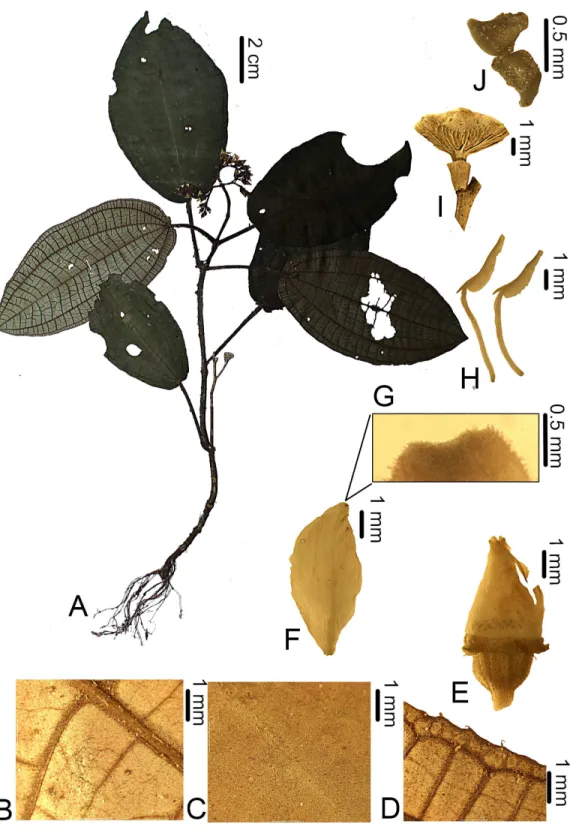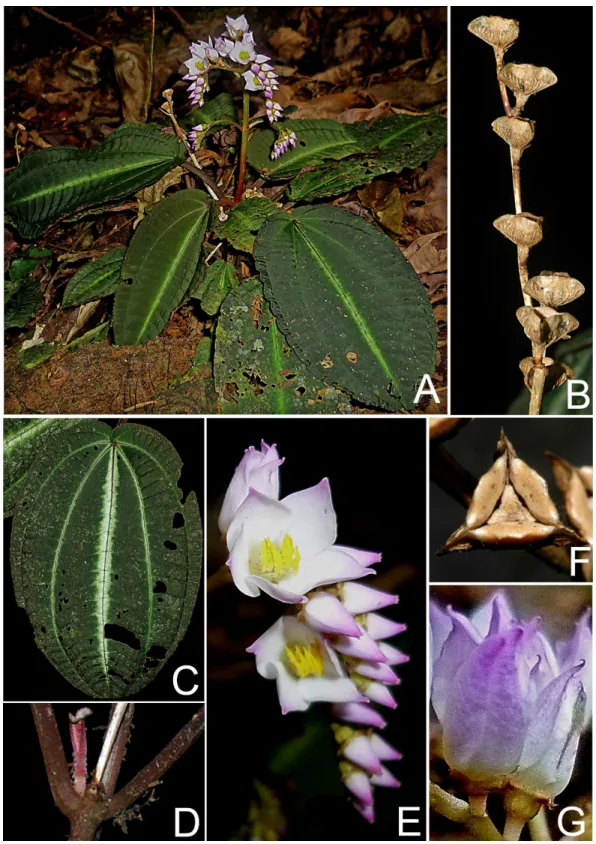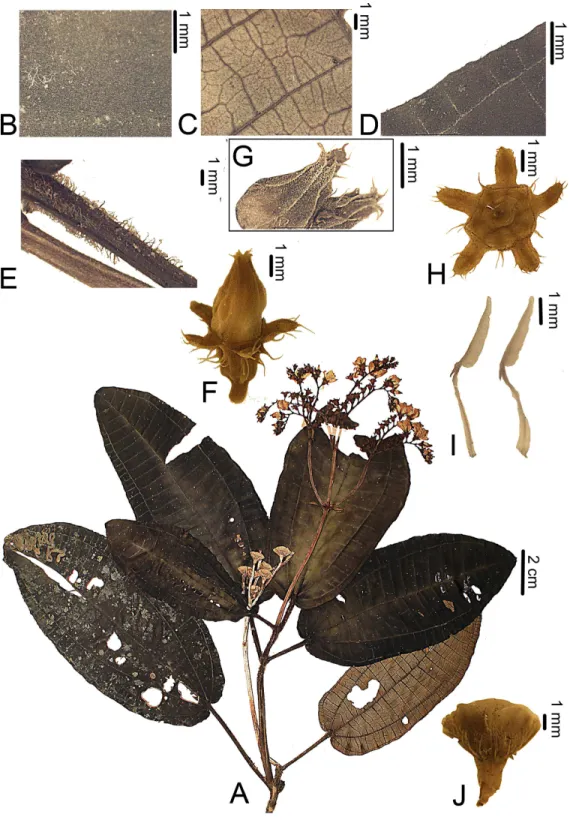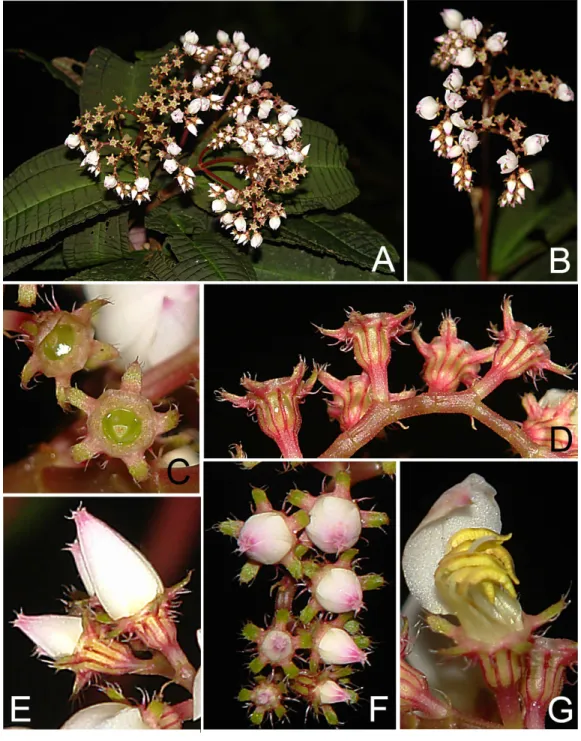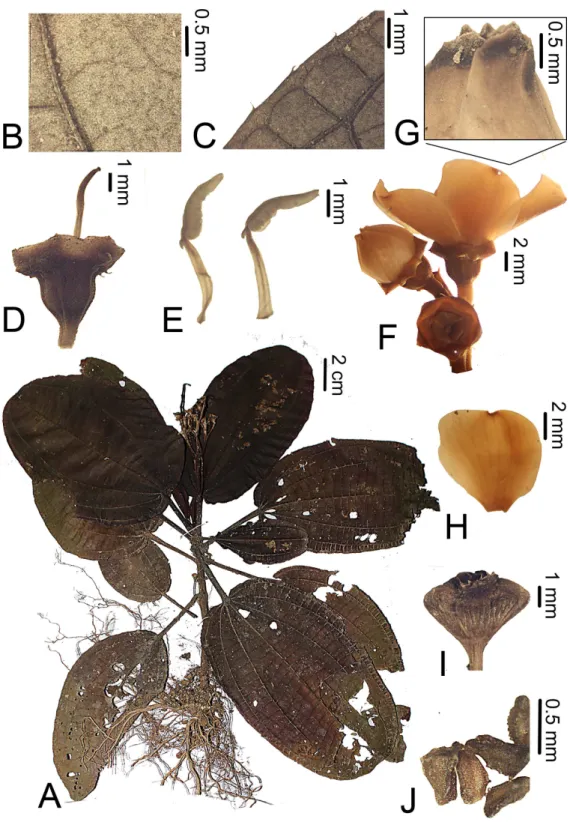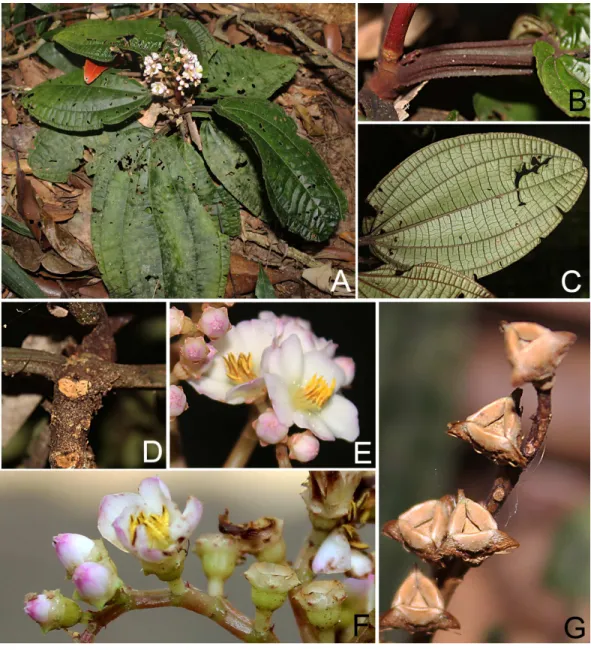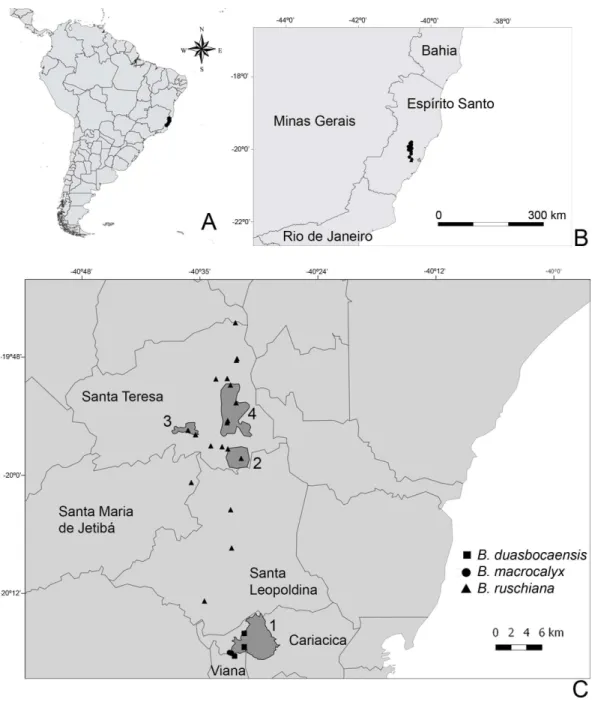Submitted7 October 2016 Accepted 22 November 2016 Published22 December 2016
Corresponding author
Lucas F. Bacci, lucasfbacci@gmail.com
Academic editor Marcio Pie
Additional Information and Declarations can be found on page 18
DOI10.7717/peerj.2822
Copyright 2016 Bacci et al.
Distributed under
Creative Commons CC-BY 4.0
OPEN ACCESS
Three new species of
Bertolonia
(Melastomataceae) from Espírito Santo,
Brazil
Lucas F. Bacci1, André M. Amorim2,3and Renato Goldenberg4
1Programa de Pós Gradua¸cão em Biologia Vegetal, Instituto de Biologia, Universidade Estadual de Campinas,
Rua Monteiro Lobato 255, Cidade Universitária Zeferino Vaz, Barão Geraldo, Universidade Estadual de Campinas, Campinas, São Paulo, Brazil
2Departamento de Ciências Biológicas, Universidade Estadual de Santa Cruz, Ilhéus, Bahia, Brazil 3Centro de Pesquisas do Cacau, Herbário CEPEC, Itabuna, Bahia, Brazil
4Departamento de Botânica, Centro Politécnico, Universidade Federal do Paraná, Curitiba, Paraná, Brazil
ABSTRACT
We describe and illustrate three new species ofBertolonia, all endemic to the state of Espírito Santo, Brazil.Bertolonia duasbocaensisandB. macrocalyx occur close to each other, in the municipalities of Cariacica and Viana.Bertolonia ruschianahas a wider distribution, occurring in the municipalities of Santa Leopoldina, Santa Maria de Jetibá and Santa Teresa. The first two species are classified as critically endangered (CR), and the latter as endangered (EN). We also present an identification key for the species of Bertoloniathat occur in Espírito Santo.
SubjectsBiodiversity, Plant Science, Taxonomy
Keywords Atlantic forest, Bertolonieae, Endemism, Taxonomy
INTRODUCTION
Bertolonia Raddi is a Neotropical genus of Melastomataceae endemic to the Atlantic Forest biome (Baumgratz, 1990;Bacci et al., 2016). The genus was previously classified as a member of tribe Bertolonieae, together with other genera of Melastomataceae that are also herbs with obtriquetrous capsular fruits, likeMonolenaTriana ex Bent. & Hook. f.,SalpingaMart. ex DC. andTriolenaNaudin (Clausing & Renner, 2001). Nevertheless, the tribe is not monophyletic, andMonolena, Salpinga and Triolenaactually belong to different evolutionary lineages (Goldenberg et al., 2012). Inside the Atlantic Forest biome, the species ofBertoloniaoccur mostly in the Atlantic Rainforest (‘‘Floresta Ombrófila Densa Submontana/Montana,’’ following the official Brazilian system—(Veloso, Rangel-Filho &
Lima, 1991). It has 22 taxa, including Bertolonia margaritaceaNaudin (until recently
Four new species ofBertoloniahave been described in the last five years (Baumgratz, Amorim & Jardim, 2011;Bacci et al., 2016;Silva-Gon¸calves et al., 2016), three from the state of Bahia and one from Rio de Janeiro. According to ‘‘Flora do Brasil’’ (Baumgratz, 2016), there should be only five species of Bertoloniaoccurring in the state of Espírito Santo: Bertolonia formosa Brade,B. foveolataBrade,B. maculataDC.,B. sanguineaSaldanha ex Cogn. andB. wurdackianaBaumgratz. Since the specimens that have been mentioned asB. sanguineaactually belong to one of the three new species described here, the total number forBertoloniain Espírito Santo should rise to seven species. Espírito Santo was originally and almost entirely covered by the Atlantic Forest Biome (Funda¸cão SOS Mata Atlântica &
INPE, 1993). Nowadays, only about 10% of the original vegetation remains (Funda¸cão SOS
Mata Atlântica & INPE, 2014). Despite the small remaining forested area and the relatively homogenous vegetation, Espírito Santo has several rare, endemic and threatened species of both fauna and flora, and can be considered a biodiversity hotspot (Dutra, Alves-Araújo & Carrijo, 2015).
We describe here three new species ofBertoloniathat are endemic to Espírito Santo, Brazil. We also provide an identification key for the species that occur in Espírito Santo, comparisons with closely related species, information about distribution and conservation status, and photos of living and dry specimens.
MATERIAL & METHODS
The authors have been collecting Bertoloniain Espírito Santo since 2008. Specimens were collected and processed following the usual procedures for botanical specimens (Mori et al., 1989). Morphological descriptions followRadford et al. (1974),Baumgratz
(1983–1985)andBaumgratz (1990). The study was based on literature (Baumgratz, 1990;
Baumgratz, Amorim & Jardim, 2011;Bacci et al., 2016) and the analysis of specimens at CEPEC, MBM, MBML, NY, RB, UPCB, VIES (acronyms according to Thiers, 2015). Ecological and geographic distribution data were also obtained from herbarium labels. Conservation status assessments were based on range size (criterion B), according to
IUCN Standards and Petitions Subcommittee (2014). The Extension of Occurrence (EOO)
and Area of Occupancy (AOO) were calculated through the GeoCAT tool (Bachman et
al., 2011). Collection permits were issued by the ‘‘Instituto Estadual do Meio Ambiente’’
(IEMA/Espírito Santo: 14489/07) for the plants inside ‘‘Reserva Biológica de Duas Bocas’’ and by the ‘‘Instituto Chico Mendes de Conserva¸cão e Biodiversidade (ICMBio: 49043-2) for the plants inside the ‘‘Reserva Biológica Augusto Ruschi.’’
work is archived and available from the following digital repositories: PeerJ, PubMed Central, and CLOCKSS.
RESULTS
Key to the species of Bertoloniafrom the state of Espírito Santo, Brazil.
1. Leaf surfaces bullate/foveolate ...2 1′
. Leaf surfaces flat ...3 2. Petioles villose; sepals margins entire; petals 5.5−7 mm long ...B. foveolata
2′
. Petioles hirsute; sepals margins fimbriate; petals 7.8−8.3 mm long ...B. wurdackiana
3. Leaves abaxial and/or adaxial surfaces permanently covered with sessile and short-stalked glands and long unbranched trichomes ...4 3′
. Leaves abaxial and adaxial surfaces covered with only sessile and short-stalked glands ...5 4. Petioles hirsute at the apex; flowers 17−22 mm long; sepals fleshy, with fimbriate
margins; petals with entire margins; anther connective with a dorsal appendage ...B. formosa 4′
. Petioles glandulose-pilose or glandulose-villose throughout; flowers 11−13 mm long;
sepals membranaceous, with entire margins; petals margins ciliate at the apex; anther connective unnapendaged ...B. maculata 5. Hypanthium covered with sessile or short-stalked glands; sepals with an acute apex; petals 6−6.5 mm long, widely obovate ...B. ruschiana
5′
. Hypanthium covered with sessile or short-stalked glands and with unbranched trichomes; sepals truncate; petals 7−12 mm, irregularly elliptic ...6
6. Flowers 13.3−14.7 mm long; calyx external teeth ca. 1 mm long, triangular, covered with
only sessile and short-stalked glands; petals long-apiculate (ca. 1 mm long), the apiculus without an unbranched trichome at the tip ...B. duasbocaensis 6′
. Flowers 9.5−11.2 mm long; calyx external teeth ca. 2 mm long, ovate, covered with
long-stalked glands (0.6−0.8 mm long) and sessile and short-stalked glands; petals
short-apiculate (ca. 0.5 mm long), the apiculus with an unbranched trichome at the tip ...B. macrocalyx
Bertolonia duasbocaensis Bacci & R.Goldenb. sp. nov.
(Figs. 1and2)
Type
Brazil. Espírito Santo: Mun. Cariacica, Reserva Biológica Duas Bocas. Localidade de Alegre, trilha do Pau-Oco. Floresta Ombrófila Densa Montana 20◦
16′
4′′
S 40◦
31′
30′′
W 525 m, 18 January 2009, fl., R. Goldenberg,C.N. Fraga, P.H. Labiak, R.C. Forzza, A.P. Fontana, L.C. KollmannandP.B. Schwartsburd 1249(Holotype: UPCB!; Isotypes: CEPEC!, MBML!).
Diagnosis
with unbranched trichomes inB. formosa), smaller flowers (13.3–14.7 mm long vs. 17–22 mm long inB. formosa), inconspicuous and truncate sepals with triangular external teeth (vs. conspicuous, 3.2–3.7 mm long sepals, these rounded and lacking external teeth) and by the petals with the apex covered with sessile or short-stalked glands (vs. petals glabrous).
Description
Herbs 10–35 cm tall, terrestrial, reptant; adventitious roots branched, growing from several points along the stem, but larger next to its base; stem 3–5 mm thick, terete and slightly costate, the older portions plagyotropic and aphyllous, the young ones erect and bearing leaves. Branches, leaves, inflorescences and bracts with sparse to dense, sessile and short-stalked (then less than 0.1 mm long) glands, young branches also with sparse unbranched trichomes. Leaves opposite, occasionally subopposite; petioles 3–9.5 cm long, quadrangular, slightly costate, covered with the same trichomes as the branches; blade 7.8– 11.7×4.5–9 cm, flat, ovate to elliptic, chartaceous, base rounded to slightly cordate, apex
rounded to slightly acute, margins entire to slightly crenulate and ciliate, adaxial surface dark-green, whitish along the primary vein, sparsely covered with sessile glands, otherwise glabrescent, abaxial surface light-green or lilac, sparsely covered with sessile glands, veins three to five, plus a shorter marginal pair that do not reach the leaf apex, basal, main veins at the abaxial surface with pocket domatia at their bases. Thyrsoids 4.5–10.7 cm long, terminal (but pseudo-lateral in older, fruiting specimens), with one pair of paraclades, these cymose, scorpioid, the branches greenish to light-pink; bracteoles 0.5–0.8 mm long, narrow-lanceolate, apex acuminate, both surfaces covered only with sessile glands. Flowers 5-merous, 13.3–14.7 mm long, on pedicels ca. 2 mm long, light green, densely covered with sessile and short-stalked glands. Hypanthium light green, 2.5–2.7×2 mm, widely
campanulate, 10-costate, with the same indument as the pedicel, seldom with scattered unbranched trichomes in its the upper half. Calyx caducous on fruits, tube ca. 0.7 mm long, sepals truncate, external teeth ca. 1 mm long, green to slightly vinaceous, triangular, apex acute, margins entire, eciliate, both surfaces with the same indument as the pedicels. Petals white, with light-pink or light-purple apex, 10.8–12×4.5–5 mm, irregularly elliptic,
base slightly atenuate, apex acute and apiculate (ca. 1 mm long), the apiculus bending outwards (to the abaxial surface of the petal), lacking trichomes at its tip, margins entire, both surfaces papillose, adaxial surface apex sparsely covered with sessile and short-stalked glands. Stamens 10, 6–7 mm long, isomorphic; filaments 3.5–4 mm long, slightly widened at the base; thecae yellow, 2–3 mm long, oblong-subulate, slightly undulate, pore apical, introrse; connective prolonged ca. 1 mm below the thecae, dorsally thickened appendage. Ovary free, apex glabrous, 3-locular, placentation axillary; style ca. 5 mm long, curved at the apex, glabrous; stigma slightly capitate, papillose. Capsules bertolonidium-type, 4–5×4.5–6 mm, obtriquetrous; seeds 0.4–0.5 mm long, triangular, tuberculate on the
dorsal angles and apex.
Distribution and conservation status
kept by the state government (IEMA/ES). It is located in the municipality of Cariacica, in central Espírito Santo, between 20◦
14′
40′′
S–20◦
18′
30′′
S and 40◦
28′ 01′′ W–40◦ 32′ 07′′ W. Its 2,910 ha are covered with well-preserved Atlantic Rainforest that protects threatened species of both fauna and flora (Novelli, 2010). In the last five years, three new plant species were described from Duas Bocas:Eugenia amorimiiFraga & Giaretta (Giaretta & Fraga, 2014),Leandra magnipetala R. Goldenb. & E. Camargo (Camargo & Goldenberg, 2011), andOuratea caulifloraFraga & Saavedra (Fraga & Saavedra, 2014). Specimens of Bertolonia duasbocaensisoccur in shaded and moist slopes at 500–600 m elev. They were collected with flowers in January and February and with fruits in January, February and July. According toIUCN Standards and Petitions Subcommittee (2014)criteria B1ab(ii)+
B2ab(ii), with EOO (Extent of Occurrence)=2.235 km2and AOO (Area of Occupancy) =12.000 km2, this species should be classified as ‘‘critically endangered’’ (CR).
Paratypes
Brazil. Espírito Santo: Mun. Cariacica, 10 January 2007, fl. and fr.,A.P. Fontanaet al. 2584 (MBML!, RB!, UPCB!); 10 January 2007, fl.,L. Kollmannet al. 9457 (MBML!); 20 July 2008, fr.,A.M.A. Amorimet al. 7571 (CEPEC!, RB!, UPCB!); 22 July 2008, fr.,R. Goldenberg1210 (CEPEC!, MBML!, RB!, UPCB!); 15 February 2008, fl. and fr.,R.C.Forzza.et al. 5035
(CEPEC!, MBM!, MBML!, RB!, UPCB!). Mun. Viana, Arredores da Reserva Biológica Duas Bocas, São Paulo de Viana, prop. do Valtinho, 700 m, 19 January 2009, fl. and fr.,R. Goldenberg et al.1257(MBML!, RB!, UPCB!).
Etymology
The epithet ‘‘duasbocaensis’’ refers to the Duas Bocas Biological Reserve, the type locality of the new species.
Remarks
Bertolonia duasbocaensisis characterized by the ovate to elliptic leaves with rounded to slightly cordate bases, margins entire to slightly crenulate and ciliate, 3–5 main veins, and covered only with sessile and short-stalked glands, the widely campanulate hypanthium, truncate sepals, triangular external calyx teeth, apiculate petals with the apex of the adaxial surface covered with sessile and short-stalked glands, and oblong-subulate stamens with a dorsally thickened appendage. The new species closely resemblesB. formosa, also endemic of the state of Espírito Santo. For more details on the distinction between the two of them, see the diagnosis above.
ovate, lacking external teeth (vs. sepals truncate, with external teeth). Both Bertolonia nymphaeifoliaandB. sanguineaare endemic to the state of Rio de Janeiro and differ from the new species by the bigger leaves, with 7–9 and 5–7 acrodromous veins, respectively (vs. 3–5 inB. duasbocaensis), petioles hirsute at the base or seldom on the whole petiole (vs. petioles covered with sessile and stalked glands, the young ones sometimes with caducous, unbranched trichomes), longer flowers, 18–23 mm long in B. sanguinea(vs. shorter ones, 13.3–14.7 mm long inB. duasbocaensis) and by the long subulate stamens with an acute extension at the apex, forming a tube below the apical pore (vs. oblong-subulate stamen, without the extension at the apex). The morphology of the calyx is also different: B. nymphaeifoliahas widely ovate, membranaceous sepals with fleshy, rounded external teeth, this forming a concave cavity on the sepals andB. sanguineahas fleshy, widely ovate sepals lacking external teeth (Baumgratz, 1990), whileB. duasbocaensishas truncate sepals with a triangular external teeth.
Bertolonia duasbocaensisclosely resemblesB. macrocalyx; both are endemic of Espírito Santo and occur very close to each other. The differences between both species are listed in the diagnosis ofB. macrocalyx(see below).
Bertolonia macrocalyx Bacci & R.Goldenb.sp.nov
(Figs. 3and4)
Type
Brazil. Espírito Santo: Mun. Viana, Arredores da Reserva Biológica Duas Bocas. São Paulo de Viana, beira da estrada. Floresta Ombrófila Densa Montana 20◦
18′
3′′
S 40◦
32′
48′′
W 575 m, 17 January 2009, fl.,R. Goldenberg,C.N. Fraga, P.H. Labiak, R.C. Forzza, A.P. Fontana, and P.B. Schwartsburd 1235 (Holotype: UPCB!; Isotypes: CEPEC!, MBML!).
Diagnosis
Bertolonia macrocalyx is similar toB. duasbocaensis. Both species have similar vegetative morphology, butB. macrocalyxhas the calyx with longer (ca. 2 mm long), ovate and ciliate external teeth (vs. shorter, ca. 1 mm long, triangular and eciliate in B. duasbocaensis), short-terete hypanthium (vs. widely campanulate hypanthium), smaller, 7–8.5×3–3.5
mm petals with the upper half of the adaxial surface densely covered with sessile and short-stalked glands (vs. bigger 10.8–12 ×4.5–5 mm petals, with only the apex of the
adaxial surface sparsely covered with sessile and short-stalked glands).
Description
Figure 4 Bertolonia macrocalyx. (A) Habit. (B) Inflorescence. (C) Frontal view of the calyx and ovary apex. (D) Lateral view of old flowers. (E) Lateral view of the flowers. (F) Frontal view of the flowers. (G) Stamens (Photos by CN Fraga).
with one pair of paraclades, these cymose, scorpioid, the branches greenish to light-pink; bracteoles ca. 0.5 mm long, linear to narrow-lanceolate, apex aristate and tipped with one glandular trichome ca. 0.5 mm long, both surfaces covered only with sessile glands. Flowers 5-merous, 9.5–11.2 mm long, on pedicels 1.5–2 mm long, light pink, densely covered with sessile and short-stalked glands. Hypanthium light green, 2.5–2.7×2 mm, short-terete,
10-costate, ridges pink, the ones between the external teeth ending in one trichome, with the same indument as the pedicel, also with unbranched trichomes, on the ridges at the apex of the hypanthium. Calyx caducous on fruits, tube ca. 0.8 mm long, sepals truncate, external teeth ca.2 mm long, with the abaxial surface pinkish, abaxial light green, covered with the same trichomes as the pedicels and also with unbranched trichomes (0.6–0.8 mm long) on the adaxial surface, ovate, apex rounded, margins entire, ciliate at the apex. Petals white, with light-pink apex, 7–8.5×3–3.5 mm, irregularly elliptic, base slightly
atenuate, apex acute and apiculate (ca. 0.5 mm long), the apiculus bending outwards (to the abaxial surface of the petal), ending in a long unbranched trichome, margins entire, both surfaces papillose, upper half of the adaxial surface densely covered with sessile and short-stalked glands. Stamens ten, 6–6.5 mm long, isomorphic; filaments 3.5–4 mm long, slightly widened at the base; thecae yellow, 2–2.5 mm long, oblong-subulate, slightly undulate, pore apical, introrse; connective prolonged ca. 1.5 mm below the thecae, with a dorsal calcar, ca. 0.3 mm long. Ovary free, apex glabrous, 3-locular, placentation axillary; style ca. 5 mm long, curved at the apex, glabrous; stigma slightly capitate, papillose. Capsules bertolonidium-type (followingBaumgratz, 1983–1985), 3.5–5×4.5–5.3 mm,
obtriquetrous; seeds unknown.
Distribution and conservation status
Bertolonia macrocalyx is endemic to the state of Espírito Santo. It had been collected only twice, both in 2008. The species occurs near the limits of the Duas Bocas Biological Reserve, in the municipalities of Cariacica and Viana. The area is covered with well-preserved Atlantic Rainforest. Bertolonia macrocalyxwas collected near a local roadside and in a private property. It occurs in shaded and moist slopes, with flowers in January and with old fruits in January, May and June. According toIUCN Standards and Petitions
Subcommittee (2014) criteria B1ab(ii)+B2ab(ii), with EOO (Extent of Occurrence)=
0 km2 and AOO (Area of Occupancy)=8.000 km2, this species should be classified as
‘‘critically endangered’’ (CR).
Paratype
Brazil. Espírito Santo: Mun. Cariacica, Reserva Biológica Duas Bocas, São Paulo Viana, beira da estrada 575 m, 06 May 2008, fr.,C.N. Fragaet al. 2049 (CEPEC!, MBML!, UPCB!).
Etymology
The epithet ‘‘macrocalyx’’refers to the calyx with long external teeth, one of the diagnostic features of the new species.
Remarks
3–5 main veins, both surfaces covered with sessile and short-stalked glands, hypanthium short-terete, light green with pinkish ridges, calyx with truncate sepals and external teeth light green on the abaxial surface, ovate and ciliate (trichomes mostly at the apex), petals with the upper half densely covered with sessile and short-stalked glands, short-apiculate, with the apiculus ending in an unbranched trichome, and stamens oblong-subulate, with a dorsally thickened connective appendage.
Bertolonia duasbocaensisalso has petals with the apex covered with sessile and short-stalked glands, but they are concentrated at the apex of the adaxial surface and are much more sparsely distributed when compared withB. macrocalyx. Another diagnostic feature ofB. macrocalyx is the morphology of the calyx: The sepals are truncate (likeB. duasbocaensis), but with a long (ca. 2 mm), ovate and ciliate external teeth. For more details, see the comments above onBertolonia duasbocaensis
Bertolonia ruschiana Bacci & R.Goldenb.sp.nov
(Figs. 5and6)
Type
Brazil. Espírito Santo: Mun. Santa Teresa, Reserva Biológica Augusto Ruschi. Beira da estrada para Goiapaba-A¸cu, após a entrada da Reserva. Floresta Ombrófila Densa Montana 19◦
52′
38′′
S 40◦
32′
20′′
W 800 m, 14 January 2016, fl. and fr.,L.F. Bacci, T. BochornyandM. Bolson 321(Holotype: UEC!; Isotypes: CEPEC!, MBML!, NY!, UPCB!).
Diagnosis
Bertolonia ruschianais similar toB. nymphaeifolia. Both have branches, adaxial suface of the leaves, pedicels and hypanthium covered only with sessile and short-stalked glands, white petals with a pinkish apex, hypanthium widely campanulate and a fleshy calyx with widely ovate sepals. The new species differs by the leaves with 5 main acrodromous veins (vs. 7–9 main acrodromous veins inB. nymphaeifolia) and with ciliate margins (vs. eciliate margins), petioles covered with sessile and short-stalked glands, seldom with unbranched trichomes (vs. petioles covered with sessile and short-stalked glands, and also hirsute), shorter flowers (8–9 mm long vs. 12–15 mm long), petals apex covered with sessile and short-stalked glands on the adaxial surface (vs. petals apex glabrous) and ovary apex glabrous (vs. ovary apex covered with glands).
Description
Herbs 10–40 cm tall, terrestrial, seldom rupicolous, reptant; adventitious roots branched, growing from several points along the stem, but larger next to its base; stem 4–7 mm thick, terete and slightly costate, the older portions plagyotropic, aphyllous, the young ones erect and bearing leaves. Branches, leaves, inflorescences and bracts with sparse to dense, sessile and short-stalked (then less than 0.1 mm long) glands. Leaves opposite, occasionally subopposite; petioles 1.5–6.4 cm long, quadrangular, costate, covered with the same trichomes as the branches, seldom with scattered unbranched trichomes at the apex; blade 9–18.5×4.5–10.5 cm, flat, ovate, elliptic to wide elliptic, chartaceous, base slightly
Figure 6 Bertolonia ruschiana. (A) Habit. (B) Petiole. (C) Abaxial surface of the leaf blade. (D) Stem. (E) Flowers and flower buds. (F) Inflorescence. (G) Infructescense. (Photos by L.F. Bacci).
pedicel. Calyx caducous, tube ca. 1 mm long, sepals ca. 1.5 mm long, widely ovate, margins entire, both surfaces covered with the same trichomes as in the pedicels, seldom with an unbranched trichome on the tip of the ridges between the sepals, external teeth 0.5–0.7 mm long, light pink, fleshy, triangular, slightly concave, sometimes forming a small cavity, with an apex ending in a small trichome, caducous. Petals white, with a light-pink apex, 6–6.5×5.7–6 mm, widely obovate, slightly convex, fleshy, base slightly atenuate, apex
rounded to obcordate, margins entire, both surfaces papillose, adaxial surface apex covered sparsely with sessile and short-stalked glands. Stamens ten, 6–7.5 mm long, isomorphic; filaments 3.5–4.5 mm long, papillose, slightly widened at the base; thecae yellow, 2.5–3 mm long, oblong-subulate, slightly undulate, pore apical, introrse; connective prolonged 0.7–0.9 mm below the thecae, dorsally thickened (0.3–0.5 mm long). Ovary free, apex glabrous, 3-locular, placentation axillary; style ca. 6 mm long, curved at the apex, glabrous; stigma slightly capitate, papillose. Capsules bertolonidium-type, 5.5–7×6–7.5 mm; seeds
0.5–0.7 mm long, triangular, tuberculate at the apex.
Distribution and conservation status
Bertolonia ruschianaoccurs in the central region of the state of Espírito Santo, in three neighboring municipalities: Santa Leopoldina, Santa Maria de Jetibá and Santa Teresa (Fig. 7). Most populations were found in Santa Teresa, within three different conservation units and in several private properties. Two populations with several individuals were found inside the Augusto Ruschi Biological Reserve, a Brazilian Federal Conservation Unit with 3,598 ha (IBAMA–Instituto Brasileiro do Meio Ambiente e Recursos Renováveis, 2000). A few specimens ofB. ruschianawere collected in some trails inside the Santa Lúcia Ecological Station and in the São Louren¸co Municipal Natural Monument (also called ‘‘Caixa D’água’’), kept by the Museu de Biologia Professor Mello Leitão (MBML). The first has 400 ha and the second has 363 ha, both covered with Atlantic Rainforest (Mendes & Padovan, 2000). Specimens ofB. ruschianausually are terrestrial or rupicolous herbs that inhabit moist and shaded slopes or rocks with shallow soil near water, but sometimes they are epiphytes growing on lower portions of tree trunks. It was collected with flowers from January to March and with fruits all year. According toIUCN Standards and Petitions
Subcommittee (2014) criteria B1ab(ii) +B2ab(ii), with EOO (Extent of Occurrence)
=298.881 km2and AOO (Area of Occupancy) =68.000 km2 , this species should be
classified as ‘‘endangered’’ (EN). It has been collected more than 30 times, inside three conservation units and several private properties. Nevertheless, its habitat is fragmented and the conservation of the species depends on the maintenance of these units.
Paratypes
Brazil. Espírito Santo: Mun. Santa Leopoldina: Santo Antônio, 24 October 1988, fr.,V. Krause s.n. (MBML 5295!); Bragan¸ca, Mata do Tyrol, prop.: Assunta Salvador, 31 October
Figure 7 Map with the collection localities of the new species: (A) South America, the state of Espírito Santo in black; (B) Detail of the state of Espírito Santo and the neighboring states, the collection points in black; (C) Collection points.Conservation Units: 1- Duas Bocas Biological Reserve, 2- Santa Lúcia Eco-logical Reserve, 3- São Louren¸co Natural Municipal Reserve, 4- Augusto Ruschi BioEco-logical Reserve.
et al. 2039 (MBML!); Esta¸cão Biológica de Santa Lúcia, 19 April 2000, fr.,L. Kollmannet al. 2869 (MBML!); Valsugana Velha, Prop. Dr. Pedro, 06 June 2001, fr.,L. Kollmann3816 (MBML);Valsugana Velha, 23 June 2001, fr.,A.P. Fontanaet al. 132 (MBML!); Valsugana Velha, Esta¸cão Biológica de Santa Lúcia, 14 September 2001, fr.,L. KollmannandE. Bausen 4553 (MBML!); Reserva Biológica de Nova Lombardia, 05 February 2002, fl. and fr.,L. Kollmannet al. 5499 (MBML!, UPCB!); Reserva Biológica Augusto Ruschi, 22 January 2003, fl.,R.R. Vervloet et al. 1718 (MBML!); Nova Lombardia, Reserva Biológica Augusto Ruschi, estrada Marlene, 05 February 2003, fl.,R.R. Vervloet et al. 1777 (MBML!, RB!, UPCB!); APP São Louren¸co, Trilha Boa, 29 March 2003, fr., A.P. Fontanaet al. 545 (MBML!, UPCB!); Nova Lombardia, Reserva Biológica Augusto Ruschi, trilha seguindo o córrego, 01 April 2003, fr.,R.R. Vervloet andE. Bausen2095 (MBML!); Reserva Biológica Augusto Ruschi, trilha da Cachoeira, 20 January 2005, fl.,H.Q.H. FernandesandR. Goldenberg 3373 (MBML!, UPCB!); Santo Henrique, 26 January 2005, fl.,L. Kollmann7308 (MBML!); Santo Henrique, beira da estrada, 26 January 2005, fl.,L. KollmannandA.P. Fontana7328 (MBML!, UPCB!); Penha, prop. sr. Tabajara Ribeiro de Oliveira, 22 May 2005, fr.,R.C. Britto58 (MBML!); Santo Anselmo, terreno do M. Nandolfo, 830 m, 24 February 2006, fr.,L. Kollmannet al. 8675 (MBML!); Julião, prop. Sr. João Luiz Rodrigues de Souza, 23 February 2007, fr.,A.P. Fontana2980 (MBML!); Nova Lombardia, Terreno do Furlani, 13 July 2007, fr.,R. Goldenberget al. 891 (MBML!, NY!, UPCB!); Lombardia, prop. de João Furlane, 19◦
48′
9′′
S 40◦
32′
14′′
W, 800 m, 4 May 2009, fr.,A.P. Fontanaet al. 5982 (MBML!, WAG); Nova Lombardia, terreno do Furlani, 7 February 2011, fr. and fl., F.A.Michelangeli et al. 1604 (NY!; UPCB!); Nova Lombardia, terreno do Furlani, 7 February 2011, fl.,F.A. Michelangeliet al. 1606 (NY!; UPCB!); Reserva Biológica Augusto Ruschi, 10 December 2012, fr., J.A. Lombardi 9819 (UPCB!); Reserva Biológica Augusto Ruschi, 27 November 2013, fr.,L.F. BacciandD.F. Lima108 (UPCB!); Reserva Biológica Augusto Ruschi, trilha da Roda D’água, 14 January 2016, fl. and fr.,L.F. Bacciet al. 317 (MBML!, NY!, UEC!, UPCB!).
Etymology
The epithet ‘‘ruschiana’’honors the Brazilian naturalist Augusto Ruschi (1915–1986), who fought against the deforestation of the Atlantic Forest, mainly in the state of Espírito Santo. In addition, the type locality of the species is in the Augusto Ruschi Biological Reserve.
Remarks
Bertolonia ruschiana is characterized by the adaxial surface of the leaves, pedicels and hypanthium covered only with sessile and short-stalked glands, the leaves with 5 main acrodromous veins and ciliate margins, hypanthium widely campanulate, sepals widely ovate and fleshy, with triangular, slightly concave external teeth. The widely depressed, slightly convex and fleshy petals with the apex of the adaxial surface covered sparsely with sessile and short-stalked glands are also important for the recognition of the new species. Bertolonia ruschianaclosely resemblesB. nymphaeifolia(for more details, see the diagnosis above).
bases, and both surfaces of the leaf covered only with sessile or short-stalked glands, butB. sanguineahas hirsute petioles and eciliate leaf margins (Baumgratz, 1990). The morphology of the flowers is also different.Bertolonia sanguineahas sepals lacking external teeth (vs. sepals with a triangular, concave external teeth inB. ruschiana), longer flowers (18–23 mm vs. 8–9 mm), glabrous petals (vs. adaxial surface apex covered with sessile and short-stalked glands), longer stamens (18–19 mm long vs. 6–7.5 mm), these with an extension at the apex, forming a tube (vs. stamens without an extension at the apex) (Fig. 7).
ACKNOWLEDGEMENTS
The authors would like to thank Cláudio N. Fraga for the photos, Paulo Labiak, Rafaela Forzza, Ludovic Kollmann, André Fontana, Thuane Bochorny and Mônica Bolson for the help in the field, and also Helio B.Q. Fernandes and the staff at MBML (Museu de Biologia Mello-Leitão) for the support in the field and for providing accommodation at Santa Lucia. We also would like to thank Fabián A. Michelangeli and Paulo J. Guimarães for the careful review of the manuscript.
ADDITIONAL INFORMATION AND DECLARATIONS
Funding
LFB received financial support from a CAPES PhD grant, AMA and RG from CNPq ‘‘Produtividade em Pesquisa,’’ grants # 310717/2015-9 and # 306852/2013-6, respectively. The fieldwork of AMA and RG in Espirito Santo State was made possible by support from the Funda¸cão O Boticário de Prote¸cão a Natureza (grant # 200720074). LFB’s fieldwork was partially funded by the National Science Foundation through grants to FA Michelangeli (DEB-818399 and DEB-1343612) The funders had no role in study design, data collection and analysis, decision to publish, or preparation of the manuscript.
Grant Disclosures
The following grant information was disclosed by the authors:
CAPES PhD grant for the Programa de Pòs-Gradua¸cão em Biologia Vegetal, UNICAMP. CNPq ‘‘Produtividade em Pesquisa’’: # 310717/2015-9, # 306852/2013-6.
Funda¸cão O Boticário de Prote¸cão a Natureza: # 200720074. National Science Foundation: DEB-818399, DEB-1343612.
Competing Interests
The authors declare there are no competing interests.
Author Contributions
• Lucas F. Bacci conceived and designed the experiments, performed the experiments,
analyzed the data, wrote the paper, prepared figures and/or tables, reviewed drafts of the paper.
• André M. Amorim and Renato Goldenberg conceived and designed the experiments,
Field Study Permissions
The following information was supplied relating to field study approvals (i.e., approving body and any reference numbers):
Collection permits for this study were issued by IEMA/ES #14489/07 and ICMBio 49043-2.
Data Availability
The following information was supplied regarding data availability: The raw data is included in the figures.
New Species Registration
The following information was supplied regarding the registration of a newly described species:
1334577158860-1 - _Bertolonia duasbocaensis, _77158861-1 - _Bertolonia macrocalyx, _77158862-1 -Bertolonia ruschiana.
REFERENCES
Bacci LF, Amorim AM, Michelangeli FA, Goldenberg R. 2016.A new species of
Bertolo-nia(Melastomataceae) from southern Bahia, Brazil.Phytotaxa265(3):251–258 DOI 10.11646/phytotaxa.265.3.5.
Bachman S, Moat J, Hill AW, De la Torre J, Scott B. 2011.Supporting Red List threat
assessments with GeoCAT: geospatial consevation assessment tool.Zookeys
150:117–126DOI 10.3897/zookeys.150.2109.
Baumgratz JFA. 1983–1985.Morfologia dos frutos e sementes de Melastomataceas
brasileiras.Arquivos do Jardim Botânico do Rio de Janeiro27:113–155.
Baumgratz JFA. 1990.O gêneroBertoloniaRaddi (Melastomataceae): revisão
taxonômica e considera¸cões anatômicas.Arquivos do Jardim Botânico do Rio de Janeiro30:69–213.
Baumgratz JFA. 2016.Bertolonia inFlora do Brasil 2020 em constru¸cão. Jardim Botânico
do Rio de Janeiro. Disponível em.Available athttp:// floradobrasil.jbrj.gov.br/ reflora/
floradobrasil/ FB9413.(accessed on 28 July 2016).
Baumgratz JFA, Amorim AM, Jardim AB. 2011.Two new species ofBertolonia
(Melastomataceae) from the Brazilian Atlantic Forest.Kew Bulletin66:273–279 DOI 10.1007/s12225-011-9281-0.
Camargo AC, Goldenberg R. 2011.Two new species ofLeandrafrom Espírito Santo,
Brazil.Brittonia63(2):220–226DOI 10.1007/s12228-010-9154-0.
Clausing G, Renner SS. 2001.Molecular phylogenetics of Melastomataceae and
Memecy-laceae: implications for character evolution.American Journal of Botany88:486–498 DOI 10.2307/2657114.
Dutra VF, Alves-Araújo A, Carrijo TT. 2015.Angiosperm checklist of Espírito Santo:
Fraga CN, Saavedra MM. 2014.A new cauliflorous white-flowered species ofOuratea (Ochnaceae) from the Brazilian Atlantic Forest.Phytotaxa167(1):119–126 DOI 10.11646/phytotaxa.167.1.8.
Funda¸cão SOS Mata Atlântica & INPE. 1993.Atlas da evolu¸cão dos remanescentes
florestais da Mata Atlântica e ecossistemas associados no período de 1985–1990. São Paulo: Funda¸cão SOS Mata Atlântica/INPE.
Funda¸cão SOS Mata Atlântica & INPE. 2014.Atlas da evolu¸cão dos remanescentes
florestais da Mata Atlântica e ecossistemas associados no período de 2005–2008. São Paulo: Funda¸cão SOS Mata Atlântica/INPE/Instituto Sócio-ambiental (ISA).
Giaretta A, Fraga CN. 2014.Two newEugeniaspecies (Myrtaceae) from the Brazilian
Atlantic Forest.Phytotaxa163(2):113–120DOI 10.11646/phytotaxa.163.2.5.
Goldenberg R, Bacci LF, Bochorny T. 2016.Behuria,Bertolonia,Cambessedesia,Huberia
eMouriri, e chave de identifica¸cão de gêneros de Melastomataceae no estado do Paraná.Rodriguesia67(2):445–454DOI 10.1590/2175-7860201667215.
Goldenberg R, Fraga CN, Fontana AP, Nicolas AN, Michelangeli FA. 2012.Taxonomy
and phylogeny ofMerianthera(Melastomataceae).Taxon61:1040–1056.
IBAMA–Instituto Brasileiro do Meio Ambiente e Recursos Renováveis. 2000.Plano
de Manejo da Reserva Biológica Augusto Ruschi. Vitória: Diretoria de Ecossistemas, 280 pp.
IUCN Standards and Petitions Subcommittee. 2014.Guidelines for using the IUCN
red list categories and criteria. Version 11 (February). Prepared by the IUCN species survival commission. IUCN Council, Gland, Switzerland and Cambridge, UK, 87 pp. Available athttp:// www.iucnredlist.org/ documents/ RedListGuidelines.pdf (accessed on 19 July 2016).
Mendes LS, Padovan MP. 2000.A Esta¸cão Ecológica de Santa Teresa, Espírito Santo.
Boletim do Museu de Biologia Mello Leitão11/12:7–34.
Mori AS, Silva LAM, Lisboa G, Coradin L. 1989.Manual de manejo de herbário
fanerogâmico. Ilhéus: Centro de Pesquisas do Cacau.
Novelli FZ. 2010.A Reserva Biológica de Duas Bocas e seus vínculos com à história da
conserva¸cão no Espírito Santo.Natureza on Line8(2):57–59.
Radford AE, Dickison WC, Massey JR, Bell CR. 1974.Vascular Plant Systematics. New
York: Harper & Row Publishers.
Silva-Gon¸calves KC, Baumgratz JFA, Nunes-Freitas AF. 2016.A new species of
Bertolo-nia(Melastomataceae) from the Southeastern Brazilian Atlantic Forest.Phytotaxa
273(2):115–121DOI 10.11646/phytotaxa.273.2.2.
Thiers B. 2015.Index herbariorum: a global directory of public herbaria and associated staff.
New York: New York Botanical Garden. Available athttp:// sciweb.nybg.org/ science2/
IndexHerbariorum.asp(accessed on 26 April 2016).
Veloso HP, Rangel-Filho ALR, Lima JCA. 1991.Classifica¸cão da vegeta¸cão brasileira,
